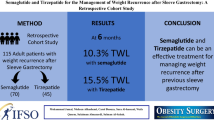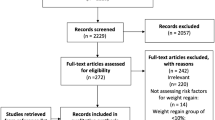Abstract
Background
Despite similar initial results on weight loss and metabolic control, with a better feasibility than the Roux-en-Y gastric bypass (RYGBP), the omega loop bypass (OLB) remains controversial. The aim of this study was to compare the short-term outcomes of the laparoscopic OLB versus the RYGBP in terms of weight loss, metabolic control, and safety.
Methods
Two groups of consecutive patients who underwent laparoscopic gastric bypass surgery were selected: 20 OLB patients and 61 RYGBP patients. Patients were matched for age, gender, and initial body mass index (BMI). Data concerning weight loss, metabolic outcomes, and complications were collected prospectively.
Results
Mean duration of the surgical procedure was shorter in the OLB group (105 vs 152 min in the RYGBP group; p < 0.001). Mean excess BMI loss percent (EBL%) at 6 months and at 1 year was greater in the OLB group (76.3 vs 60.0 %, p = 0.001, and 89.0 vs 71.0 %, p = 0.002, respectively). After adjustment for age, sex, initial BMI, and history of previous bariatric surgery, the OLB procedure was still associated with a significantly greater 1-year EBL%. Diabetes improvement at 6 months was similar between both groups. The early and late complication rates were not statistically different. There were three anastomotic ulcers in the OLB group, in smokers, over 60 years old, who were not taking proton pump inhibitor medication.
Conclusions
In this short-term study, we observed a greater weight loss with OLB and similar efficiency on metabolic control compared to RYGBP. Long-term evaluation is necessary to confirm these outcomes.

Similar content being viewed by others
References
Sjostrom L, Lindroos AK, Peltonen M, et al. Lifestyle, diabetes, and cardiovascular risk factors 10 years after bariatric surgery. N Engl J Med. 2004;351:2683–93.
Maggard MA, Shugarman LR, Suttorp M, et al. Meta-analysis: surgical treatment of obesity. Ann Intern Med. 2005;142:547–59.
Buchwald H, Avidor Y, Braunwald E, et al. Bariatric surgery: a systematic review and meta-analysis. JAMA. 2004;292:1724–37.
Griffen Jr WO, Young VL, Stevenson CC. A prospective comparison of gastric and jejunoileal bypass procedures for morbid obesity. Ann Surg. 1977;186:500–9.
Santry HP, Gillen DL, Lauderdale DS. Trends in bariatric surgical procedures. JAMA. 2005;294:1909–17.
DeMaria EJ, Pate V, Warthen M, et al. Baseline data from American Society for Metabolic and Bariatric Surgery-designated Bariatric Surgery Centers of Excellence using the Bariatric Outcomes Longitudinal Database. Surg Obes Relat Dis. 2010;6:347–55.
Saber AA, Elgamal MH, McLeod MK. Bariatric surgery: the past, present, and future. Obes Surg. 2008;18:121–8.
Lee WJ, Yu PJ, Wang W, et al. Laparoscopic Roux-en-Y versus mini-gastric bypass for the treatment of morbid obesity: a prospective randomized controlled clinical trial. Ann Surg. 2005;242:20–8.
Reddy RM, Riker A, Marra D, et al. Open Roux-en-Y gastric bypass for the morbidly obese in the era of laparoscopy. Am J Surg. 2002;184:611–5. discussion 5-6.
Christou N, Efthimiou E. Five-year outcomes of laparoscopic adjustable gastric banding and laparoscopic Roux-en-Y gastric bypass in a comprehensive bariatric surgery program in Canada. Can J Surg. 2009;52:E249–58.
Rutledge R. The mini-gastric bypass: experience with the first 1,274 cases. Obes Surg. 2001;11:276–80.
Rutledge R, Walsh TR. Continued excellent results with the mini-gastric bypass: six-year study in 2,410 patients. Obes Surg. 2005;15:1304–8.
Peraglie C. Laparoscopic mini-gastric bypass (LMGB) in the super-super obese: outcomes in 16 patients. Obes Surg. 2008;18:1126–9.
Lee WJ, Ser KH, Lee YC, et al. Laparoscopic Roux-en-Y vs. mini-gastric bypass for the treatment of morbid obesity: a 10-year experience. Obes Surg. 2012;22:1827–34.
Noun R, Skaff J, Riachi E, et al. One thousand consecutive mini-gastric bypass: short- and long-term outcome. Obes Surg. 2012;22:697–703.
Fisher BL, Buchwald H, Clark W, et al. Mini-gastric bypass controversy. Obes Surg. 2001;11:773–7.
Lonroth H, Dalenback J, Haglind E, et al. Laparoscopic gastric bypass. Another option in bariatric surgery. Surg Endosc. 1996;10:636–8.
American Diabetes Association. Executive summary: standards of medical care in diabetes. Diabetes Care. 2011;34(1):S4–10.
Zingg U, McQuinn A, DiValentino D, et al. Revisional vs. primary Roux-en-Y gastric bypass—a case-matched analysis: less weight loss in revisions. Obes Surg. 2010;20:1627–32.
Ochner CN, Teixeira J, Geary N, et al. Greater short-term weight loss in women 20-45 versus 55-65 years of age following bariatric surgery. Obes Surg. 2013;23:1650–4.
Contreras JE, Santander C, Court I, et al. Correlation between age and weight loss after bariatric surgery. Obes Surg. 2013;23:1286–9.
Buchwald H, Estok R, Fahrbach K, et al. Weight and type 2 diabetes after bariatric surgery: systematic review and meta-analysis. Am J Med. 2009;122:248–56. e5.
Hamdan K, Somers S, Chand M. Management of late postoperative complications of bariatric surgery. Br J Surg. 2011;98:1345–55.
Dapri G, Cadiere GB, Himpens J. Superobese and super-superobese patients: 2-step laparoscopic duodenal switch. Surg Obes Relat Dis. 2011;7:703–8.
Gumbs AA, Duffy AJ, Bell RL. Incidence and management of marginal ulceration after laparoscopic Roux-Y gastric bypass. Surg Obes Relat Dis. 2006;2:460–3.
Bege T, Berdah SV, Moutardier V, et al. [Risks related to tobacco use in general and intestinal surgery]. J Chir (Paris). 2009;146:532–6.
Delgado-Rodriguez M, Medina-Cuadros M, Martinez-Gallego G, et al. A prospective study of tobacco smoking as a predictor of complications in general surgery. Infect Control Hosp Epidemiol. 2003;24:37–43.
Conflict of Interest
The authors certify having no disclosure and no commercial interest in the subject of study.
Author information
Authors and Affiliations
Corresponding author
Rights and permissions
About this article
Cite this article
Disse, E., Pasquer, A., Espalieu, P. et al. Greater Weight Loss with the Omega Loop Bypass Compared to the Roux-en-Y Gastric Bypass: a Comparative Study. OBES SURG 24, 841–846 (2014). https://doi.org/10.1007/s11695-014-1180-7
Published:
Issue Date:
DOI: https://doi.org/10.1007/s11695-014-1180-7




